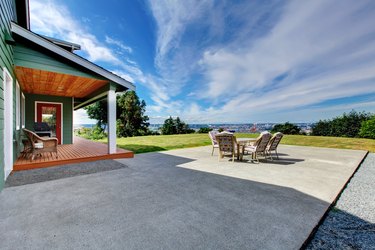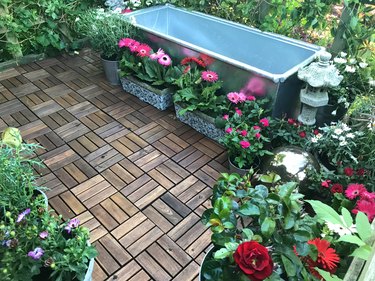
Concrete patios are durable and practical, but that doesn't mean they have to look boring or utilitarian. There are several DIY methods you can use to spruce up the look of your outdoor space, from paint to pavers and beyond. Which one you choose will depend on your personal taste and the condition of the slab with which you're working.
Resurface Your Concrete Patio
Video of the Day
Sometimes the issue isn't that your concrete patio looks a bit drab — it's that it looks aged and worn. As they age, concrete patios can chip, flake and crack. If these are the issues that are bringing down the look of your outdoor space, resurfacing the concrete is likely the easiest and fastest solution. You'll begin by power washing the patio to remove stains as well as chips or flakes.
Video of the Day
When the surface is clean, mix a concrete patch and crack filler with some water to make it a spreadable consistency. Some products come ready to use and require no mixing. Using a trowel, spread your repair compound into and over any cracks or chips in the concrete and allow it to dry. You can then spread a concrete resurfacer like Re-Cap evenly over your patio. If desired, you can sweep over the drying concrete with a broom to create a nonslip texture.
Concrete resurfacing materials cure quickly, and you can walk on your new surface as early as eight hours after application. Generally, a 40-pound bag of concrete resurfacer will cover 90 square feet spread to a thickness of 1/8 inch.
When you finish this project, you may find that your concrete patio needs something more. A resurfaced concrete slab still looks like a concrete slab. You may find that you still wish to stain the patio or paint a colorful faux rug onto it using stencils. Now that you've refinished your concrete, you'll have a better base upon which to build if you wish.
Stamped Concrete Overlay
When concrete patios are installed, many homeowners opt to stamp the concrete so that it has the appearance of stone or bricks. Even if you purchased your home long after the concrete was originally poured, you haven't necessarily missed your window.
To add a concrete stamp after the fact to your backyard patio, you'll lay fresh concrete over your existing patio in the same way as you would if you were resurfacing it. The material must be thicker for stamping, however, so your overlay will need to be 1/4 to 3/4 inch thick depending on the stamp you are using.
After smoothing on your overlay, you'll need to work quickly but carefully to stamp your concrete. You have a limited amount of time to stamp the concrete before it begins to set, and the timing can be tricky. If you have any doubts, you may want to consider hiring a professional for this home improvement job.
Paints and Stains
Applying stains and paint to a concrete patio is a great DIY method of upgrading the appearance of your outdoor living space. When using them, you can get as creative as you like or stick to the basics if you prefer.
To paint or stain your patio, wash it with a power washer and allow it to dry thoroughly before you begin working. You can then choose a concrete stain or outdoor paint (make sure it's designed for concrete) in a color you like and apply it with a roller. Stains often require more than one coat depending on how deep you want the color to be.
This project can be as simple as that, but it doesn't have to be. Some design ideas include mimicking the look of a tile floor by placing masking tape in a square or diamond pattern on the patio before you stain or paint it. This will leave bare spots that look like grout lines between tiles.
You can also make a faux geometric rug with paint. Find a pattern that you like online or create your own. Draw the pattern onto your patio using a yardstick and a pencil. You can then tape around each square and paint it the desired color. Thinning the paint a bit and then applying it with a sea sponge will add a texture that mimics the look of a fiber carpet.
You can even take things a step further by using a stencil to create designs on your concrete to make your faux carpet even more visually interesting. Your imagination is your only limit when painting designs on your concrete. The more complicated you go, however, the longer your project will take. Allow your paint or stain to dry thoroughly and then apply a concrete sealer to protect it (make sure the sealer is compatible with the paint).
Apply Pavers Over Your Patio
One way to give your concrete patio a makeover is to apply pavers on top of it. There are two caveats here, however. One is the height of your patio door. You need to have enough space between the patio and the bottom of the door so that your pavers won't interfere with opening and closing the door.
The second caveat is the condition of your outdoor patio. If you want to cover the patio simply because you don't find it attractive, you're good to go. If there are ever-widening or lengthening cracks in your concrete, however, it won't provide a stable base for your pavers. In this case, consider filling the crack and then covering the patio with a stain or rug instead of pavers.
To install pavers, begin by laying the outline around the edge of the patio. Use a construction adhesive to attach the outside pavers to the patio. To ensure good contact, power wash the edges of your patio where the construction adhesive will go.
After completing your border, lay landscaping fabric over your patio. This will keep weeds from growing up through any cracks and will let you keep your sand where you want it. After laying the fabric, spread leveling sand across your patio and even it out with a straight 2x4 board.
Lay out your pavers in your desired design. You can then tamp them down and make sure they're flush with one another. After tamping, cover the patio with polymeric sand, sweep it into the cracks between pavers and tamp down the pavers again. You can now dampen the patio to activate the adhesive polymers in the sand.

Lay Tiles Over the Concrete
Laying tile over your patio is another good DIY concrete patio cover-up. If you choose tile, make sure you select one suitable for outdoor use. You'll also want to pay attention to the tile's coefficient of friction (COF).
The COF is a rating that tells you how slippery the tile will be when it's wet. A tile's COF is rated on a scale of 1 to 10, with 1 being the most slippery and 10 providing the most grip. For use in an outdoor space, you'll want a tile with a COF of 7 or higher.
Like pavers, tiles also require a fairly flat and smooth base. Tiles are less forgiving, however, because they sit directly on the concrete patio unlike the pavers, which sit on sand. If your patio has a few shallow dings or divets, you can simply fill them in with tile adhesive as you work. If you have bigger issues, however, it's better to level and smooth the surface with a self-leveling concrete before installing tile.
You'll begin by washing your concrete patio using a scrub brush, warm water and some trisodium phosphate (TSP). You can then begin applying tile adhesive onto the concrete and laying your tile. Use spacers to keep the grout lines between your tiles the same size as you work. When the tile adhesive has cured, go back and grout the tile. Let the grout cure fully and then seal it to keep it clean and protected.
Install Wood Decking
There's no question that wood decking looks better than a builder-grade concrete patio, and this is the ultimate concrete patio cover-up. Before you build a deck over yours, though, you should consider your dedication to maintenance. Wooden decking requires periodic restaining, while concrete needs virtually no care. You'll be turning your low-maintenance concrete patio into a higher-maintenance wooden deck (unless you use pricey composite decking), so make sure that's what you really want.
Like several other patio cover-ups, decking requires you to have enough space between the deck and the patio door. Decking will raise the height of your patio by 2 1/2 to 3 1/2 inches, so make sure you'll be able to easily open and close the door once your deck is complete.
Begin by checking your patio for low spots and drainage issues. If you get a puddle in the same spot every time it rains, cover that part of your patio with a self-leveling concrete to fill in the low spot. You'll then install sleepers on the concrete.
Sleepers are pressure-treated 2x4 boards that sit under your decking and run in the opposite direction of the deck boards. Your deck won't have to be level (the patio will likely slope away from the house for drainage), but it will have to create a flat plane. To achieve this, plane across the sleepers with a level or straightedge and add flat or wedge-shaped plastic shims under sleepers that need to be raised a bit.
Secure the sleepers to the concrete using concrete screws. Using spacers made of 1/2-inch-thick PVC trim board under the sleepers keeps the wood away from the concrete and allows for drainage underneath them; a lot of moisture will fall through the decking and onto the patio surface below.
Cover the tops of your sleepers with flashing tape to help forestall rot and then install your decking onto your sleepers. When the deck is done, you'll need to stain it to protect it from the weather if you used wood rather than a composite decking material.

Buy an Outdoor Rug
This admittedly isn't a meaty DIY project, but it does offer a simple solution. Many home decor stores sell rugs made for outdoor use. The simplest way to cover your patio is to simply cover it with an outdoor carpet. You can then purchase outdoor seating and pillows to create a posh outdoor living space in just a few minutes.
The biggest benefit of going this route is that you can easily change your mind later. Even if you paint a faux rug onto your patio, you may find yourself growing tired of the color or design in time.
You can also spice up a boring concrete patio with some planters, lanterns and other outdoor accessories like a fire pit or an outdoor dining table. Keep in mind that a concrete patio serves as the perfect backdrop for extravagant designs and accessories since it's too dull to interfere. An outdoor rug is a great way to spruce things up until you have the time or the budget to cover your patio with a more permanent solution.